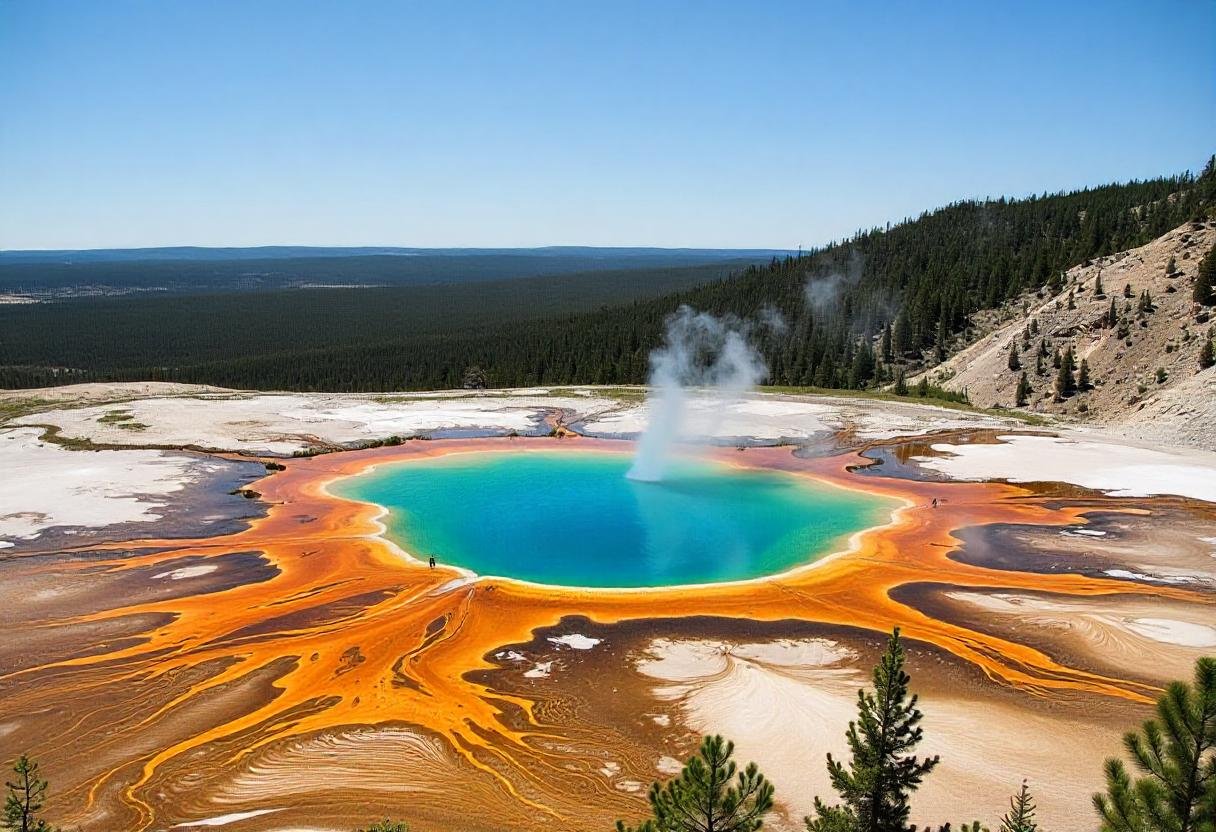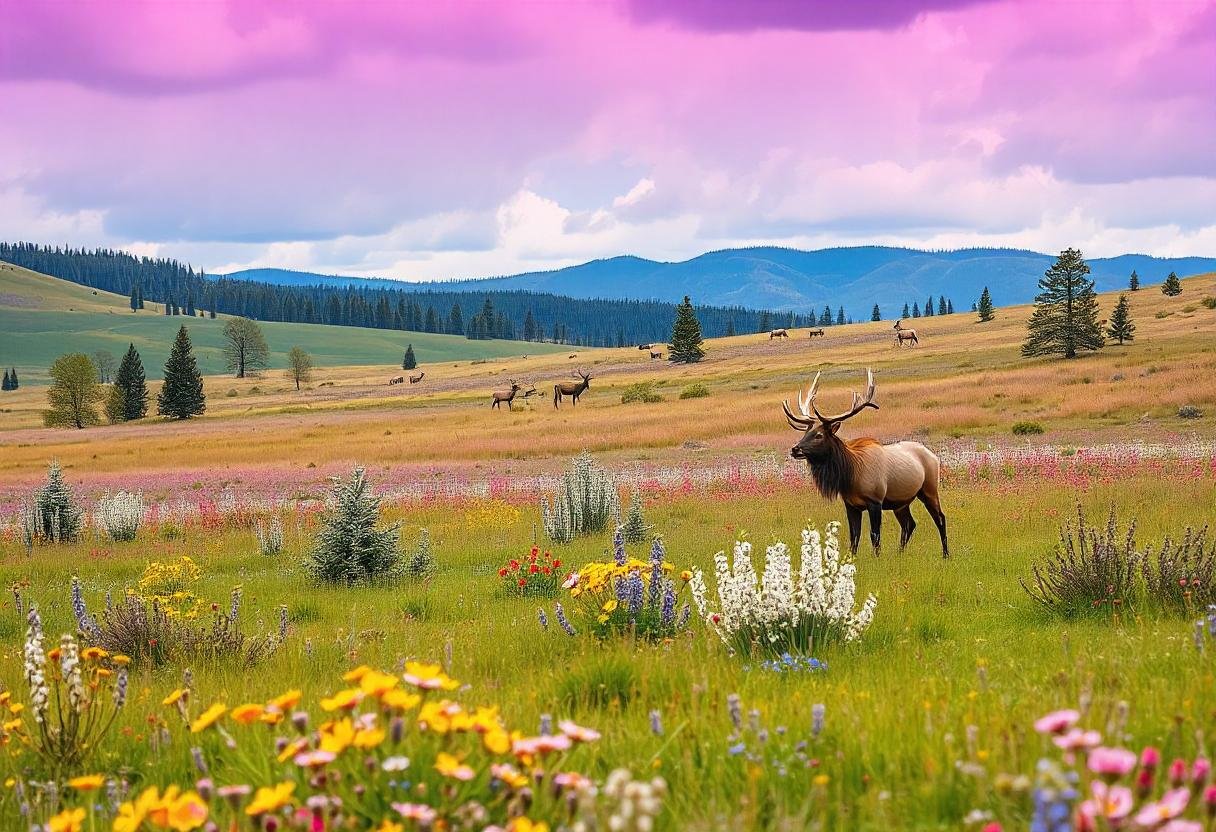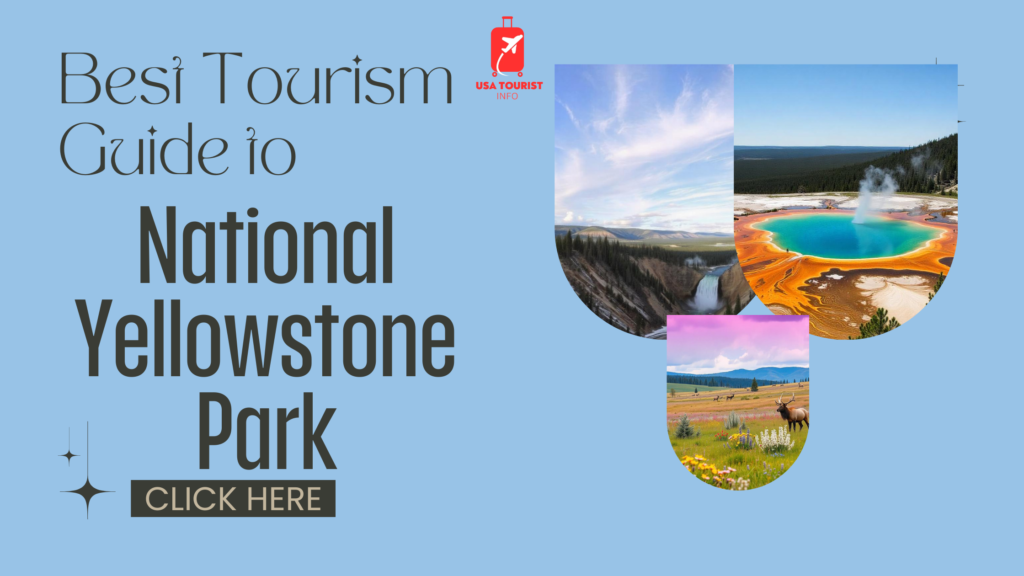Table of Contents
Introduction

Nestled in the heart of the Rocky Mountains, National Yellowstone Park is America’s first national park and a breathtaking natural wonder that spans over 3,400 square miles across Wyoming, Montana, and Idaho. Known for its stunning landscapes, diverse wildlife, and geothermal features, Yellowstone attracts millions of visitors each year. Whether you’re a nature lover, an adventure seeker, or a history enthusiast, this guide will help you navigate the park’s many attractions and ensure you make the most of your visit.
Getting There
Entrance Points
Yellowstone has five entrance stations: North, Northeast, East, South, and West. Each entrance offers unique access to different park features and attractions. The most popular is the West Entrance, which is conveniently located near the town of West Yellowstone, Montana. The North Entrance, at Gardiner, Montana, is the only entrance open year-round, providing access to the Mammoth Hot Springs area even in winter.
Transportation
While the park has limited public transportation options, the best way to explore Yellowstone is by car. Several rental agencies operate in nearby towns, and parking is available at major attractions. If you prefer a guided experience, consider booking a tour that provides transportation and insight from knowledgeable guides.
Best Time to Visit
Seasons
Yellowstone is open year-round, but each season offers a different experience.
- Summer (June to August): This is the peak season, characterized by warm weather, abundant wildlife, and nearly all park facilities open. Expect crowds and plan accommodations well in advance.
- Fall (September to October): The weather is cooler, and crowds begin to thin out. This is an excellent time for photography, as the foliage changes color and wildlife becomes more active.
- Winter (November to March): A magical time to visit, with snow-covered landscapes and fewer visitors. Winter access is limited to snowmobiles and snow coaches, offering unique experiences like guided tours and wildlife spotting.
- Spring (April to May): A quieter time as the park wakes up from winter. Snow melts, flowers bloom, and wildlife emerges, making it a great time for birdwatching.
Check Out: Visiting The Amazing Grand Canyon National Park.
Must-See Attractions
Old Faithful
No visit to Yellowstone is complete without witnessing Old Faithful, the park’s most famous geyser. Eruptions occur approximately every 90 minutes, shooting water up to 185 feet in the air. Arrive early to secure a good viewing spot and consider exploring the surrounding geothermal features in the Upper Geyser Basin.
Grand Prismatic Spring
One of the park’s most stunning sights, the Grand Prismatic Spring, is the largest hot spring in the United States. Its vibrant colors—brilliant blues, greens, and oranges—are caused by microbial mats that thrive in the warm water. A hike to the overlook provides an incredible panoramic view.
Yellowstone Lake
Covering over 136 square miles, Yellowstone Lake is the largest high-elevation lake in North America. Ideal for fishing, boating, and kayaking, the lake’s shores offer scenic picnic spots. The area is also home to the Lake Hotel, a historic lodging option that dates back to 1891.
Mammoth Hot Springs
The unique limestone terraces of Mammoth Hot Springs are a must-see. The colorful formations are created by hot mineral-rich waters that flow down the hillside. The area is also home to the Mammoth Hot Springs Hotel, a historic lodge that provides easy access to this geothermal wonder.
Grand Canyon of the Yellowstone
This breathtaking canyon, carved by the Yellowstone River, features stunning views, hiking trails, and the spectacular Upper and Lower Falls. The canyon’s vibrant colors—ranging from yellows to reds—are created by the mineral-rich rocks and the erosion over thousands of years.
Wildlife Viewing
Yellowstone is home to a diverse range of wildlife, including bison, elk, wolves, bears, and more. The Lamar Valley is renowned for its wildlife viewing opportunities, especially for those looking to spot wolves. Early morning and late evening are the best times for sightings.
Outdoor Activities

Hiking
With over 900 miles of trails, Yellowstone offers hikes for every skill level. Popular trails include the Fairy Falls Trail, which leads to stunning views of the falls, and the Mount Washburn Trail, known for its panoramic vistas of the park.
Camping
Yellowstone has twelve campgrounds, providing a range of options from rustic tent camping to RV sites. Reservations are highly recommended during peak season. Camping allows you to immerse yourself in the park’s natural beauty and enjoy starlit skies away from city lights.
Fishing
Yellowstone boasts some of the best fishing opportunities in the country. The park’s lakes and rivers are home to cutthroat trout, rainbow trout, and more. Be sure to obtain a fishing permit and follow park regulations.
Photography
The park’s diverse landscapes and wildlife offer endless photography opportunities. Dawn and dusk are the best times for capturing stunning images, as the soft light enhances the natural beauty.
Accommodations
Lodging Inside the Park
Yellowstone has several lodges and cabins within the park, including the historic Old Faithful Inn and Lake Yellowstone Hotel. These accommodations allow you to experience the park’s beauty firsthand but tend to fill up quickly, so book early.
Lodging Outside the Park
If you prefer more options, towns like West Yellowstone, Gardiner, and Cody offer hotels, motels, and vacation rentals. Staying outside the park can also provide a chance to explore local attractions and dining options.
Tips for Visiting

Be Prepared
Yellowstone’s weather can change rapidly, so dressing in layers and bringing rain gear is essential. Make sure to carry plenty of water, snacks, and a first-aid kit.
Follow Park Regulations
To protect wildlife and preserve the park’s natural beauty, always follow park rules. Stay on designated trails, do not approach or feed wildlife, and dispose of trash properly.
Stay Informed
Check the National Park Service website for up-to-date information on road conditions, closures, and any safety alerts. Mobile service may be limited in certain areas, so downloading maps in advance can be helpful.
Leave No Trace
Practice Leave No Trace principles to minimize your impact on the environment. This includes packing out what you pack in, staying on trails, and respecting wildlife.
Conclusion
Yellowstone National Park is a treasure trove of natural beauty, adventure, and wildlife. Whether you’re exploring geothermal wonders, hiking scenic trails, or enjoying the park’s diverse ecosystems, there’s something for everyone. By planning and respecting the park’s rules, you’ll ensure a memorable experience in this remarkable destination. Whether it’s your first visit or your tenth, the allure of Yellowstone is undeniable, calling you back to its stunning landscapes and vibrant wildlife.
For more in-depth info: Click Here.
FAQs
What is the best time to visit Yellowstone National Park?
The best time to visit Yellowstone varies by preference. Summer (June to August) is ideal for warm weather and full accessibility, while spring (April to May) and fall (September to October) offer fewer crowds and beautiful scenery.
Can I see wildlife in Yellowstone?
Yes! Yellowstone is home to diverse wildlife, including bison, elk, wolves, and bears. The Lamar Valley is particularly renowned for wildlife viewing, especially in the early morning and late evening.
Are there any lodging options inside Yellowstone?
Yes, Yellowstone offers several lodging options within the park, including historic lodges and cabins. However, reservations are highly recommended, especially during peak season.



